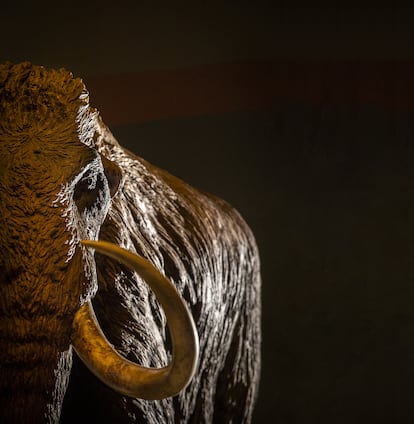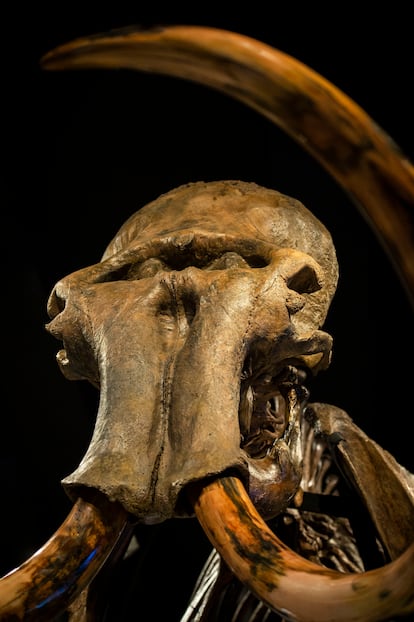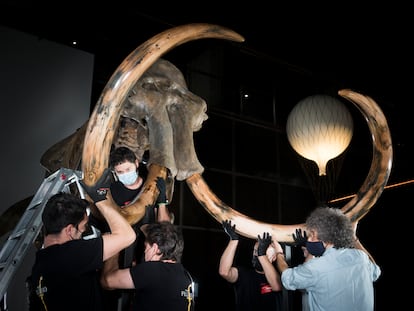The return of the mammoths: The giants of the Ice Age reappear to serve as a warning for the future
The largest mammal ever to roam Earth competes in our imagination with the dinosaurs as it coexisted with humans until only 4,000 years ago. Books, films and a grand exhibition have brought back the giants of the Ice Age bearing a cryptic warning: was the climate or human behavior the cause of their extinction?

Prehistory represents the epoch of finality. It was the last period of coexistence of different species of human beings, and of the eight, we, the Homo sapiens, are the only ones to have survived. It was also the point when most of the planet’s inhabitants abandoned nomadism, hunting and foraging as a way of life, to devote themselves to agriculture, cattle raising and the building of cities. This was precisely when kings and priests began to emerge. It also marked the end of a long glaciation and a sweeping change in climate. At that time, as now, many people saw how the places they knew and that had permitted them to survive for generations were gradually flooded and submerged under the waves while the deserts expanded. Many species of animals became extinct, which is also the case today.
From all of those species, there is one that continues to fascinate us more than any other, because it epitomizes both the strength and fragility of nature, for it shows us that other beings were once here before us, only to disappear. Mammoths, those giants of the Ice Age — though they adapted to diverse climates and latitudes —, take center stage in an intriguing exhibition at CaixaForum in Madrid. This display has previously passed through other Spanish cities and occupies a central role in the latest novel by Spanish writer Álex Prada, La parte blanda de la montaña (Seix Barral), and in the recent essay by American researcher Dan Flores, Wild New World. The Epic Story of Animals and People in America (W. W. Norton & Company).
“It is both a real and a supernatural animal,” writes the French prehistorian Marylène Patou-Mathis in Histoires de Mammouth (History of the Mammoth, Fayard). “It is contemporary to our ancestors, it belongs to the past, but it still resides in our imagination,” continues the author of The Prehistoric Man is also a Woman (Lumen). Mammoths constitute a formidable cultural icon, recalls Patou-Mathis, from Manny, one of the three main characters in the Ice Age animated films, to the Rahan comic books and the countless exhibitions that have travelled around the world in recent decades.
The 1911 novel, The Quest for Fire, shaped the view of prehistory at a time when many discoveries about humanity’s distant past were yet to be made. The Belgian brothers, under the pseudonym J.-H. Rosny, depicted mammoths as allies of Homo sapiens in their struggle against another flesh-eating species of mankind. “They knew they were the lords of the land,” reads the novel, which was made into a film by Jean-Jacques Annaud under the same title. “The column of clay-colored giants, with their coarse coats, lined the length of the pond and began to drink with such vigor that the level of the water began to decrease.”

This image encapsulates everything that mammoths represent in the popular imaginary of the prehistoric age, a kind of tranquil presence that should not be confronted without the necessary means and know-how. Yet they died out like all those gigantic creatures that Antonio Monclova details in his book La primera megafauna: La apasionante historia de los mamíferos más fabulos y extraños que habitaron la Tierra tras la extinción de los dinosaurios (The first megafauna: The exciting story of the most fabulous and unusual mammals that inhabited Earth after the extinction of the dinosaurs, Almuzara). This process spanned tens of thousands of years. When the last mammoths vanished some 4,000 years ago, taking refuge on the Arctic island of Wrangel (now part of Russia), mankind had embarked on the long Neolithic journey and there was little left — in prehistoric terms — for the construction of pyramids and the invention of writing. Global warming brought an end to their existence, but more and more experts believe that human intervention was also to blame.
“The end of glacial climates may have affected northern species such as woolly mammoths,” Dan Flores, an American wildlife expert and author of the landmark book, Coyote America, explains by email. “But, like modern elephants, the mammoth species of the south (such as the Columbians) adapted to warm climates. The end of the Ice Age did not affect them, and yet they too disappeared. I think humans played a big part in the extinction of mammoths all over the planet, but they probably didn’t actually kill them all in a literal sense. In contrast, it is likely that the remaining dispersed populations succumbed (as was the case on Wrangel Island) to the diminishing genetic diversity, which eventually led to the impossibility of reproduction. The term for this is ‘genetic fusion.’”
This relatively recent extinction relates to two of humanity’s pressing concerns. Firstly climate change, whose predicted consequences can be seen in David Wallace-Wells’s book, The Uninhabitable Earth (Debate). Secondly, the ongoing actions of human beings that are making life increasingly difficult for many other species, something that the American author Elizabeth Kolbert has termed The Sixth Extinction (Crítica).

According to Darío Fidalgo, paleontologist at the Department of Paleobiology of the National Museum of Natural Sciences, which belongs to the Spanish National Research Council (CSIC), our fascination with mammoths stems as much from their enormity as from the somewhat apocalyptic vision they cast of our own present reality. “In mammoths, we encounter two ingredients needed to succeed in our collective imagination,” he explains. “Along many millennia, these animals were the largest that have populated the terrestrial surface of Europe, Asia and America. Nevertheless, along with their sheer size, we find a convulsive history of recent extinction, caused by climate change, but driven by humans. So, from my point of view, the combination of a familiar animal species, of such considerable size that populated practically the entire Northern Hemisphere, with a direct relationship with humans since such a distant past, and whose recent and certainly morbid history of disappearance, creates a rather complex profile for an animal that arouses fascination.”
In La parte blanda de la montaña, the Seville-born, Madrid-based writer Álex Prada explores the end of the mammoths and, to some extent, their reappearance, in two parallel eras separated by thousands of years. Their story is told in two narratives: in one of them, Prada recounts the story of a hunter 6,000 years ago who wants to find a mammoth, an increasingly rare animal, which resembles a shifting mountain. This prehistoric account intersects with that of the 21st century Mongolian Khünbish, who wants to enter the booming business of mammoth tusk trafficking in order to escape poverty. As the thaw caused by the global climate crisis — which particularly impacts the areas where woolly mammoths once roamed — is now causing the remains of these giants to surface from the permafrost, the Arctic’s permanently frozen land, which is thawing quickly. In some cases, they are completely intact calves and in others, ivory tusks that represent tremendous value in a market where the trafficking of elephant tusks is being increasingly pursued.
“Although they may not be as popular as dinosaurs, their extinction is also highly symbolic and is the subject of numerous hypotheses,” says Prada. “From time to time, all this is fueled by news that informs us about experiments that could reproduce mammoths from their DNA. In my novel, the emotional nature of their disappearance and the emergence of their remains centuries later serve as the central pillars of the plot. It is full of philosophy that makes us think and reconsider the endings, their causes, their consequences and the sentimental burden that all of this entails.”

Dira, the hunter from the late prehistoric period created by Prada, not only reflects the images that literature has conjured up of the relationship between humans and mammoths for hundreds of thousands of years. This connection has been supported by countless archaeological remains. The third part of Earth’s Children by Jean Auel — the American writer who has sold 45 million copies of her prehistoric saga — is titled The Mammoth Hunters (Maeva). She depicts things like sophisticated tents — which bear no resemblance to the caves where we imagine our ancestors, who probably used them more for painting than for dwelling — mainly made of mammoth bones and tusks. Numerous excavations have shown that the remains of these huge creatures were central to the building of living spaces.
It is impossible to ascertain what prehistoric art was all about because its meaning has been lost with the transition from one cultural universe to another, it can only really be classified and analyzed statistically. However, there are plenty of suggestions that mammoths occupied a significant place in that spiritual world, not only because of the abundance of depictions — beyond the French Rouffignac cave known as “the cave of the 100 mammoths,” they are not as common as reindeer, horses or bison, even though they do appear frequently —, but also because they were utilized to design the everyday environment, as well as a sacred one.
Right at the outbreak of World War II, in August 1939, two researchers discovered fragments of mammoth ivory in the Hohlenstein-Stadel cave in the state of Baden-Württemberg (southern Germany). This was on the last day of excavation, and those pieces of ivory survived the conflict. In 1969, the archaeologist Joachim Hahn began to put the puzzle together, which was not completed until 2012, years after his death, as more fragments appeared later. This was one of the great discoveries in European prehistory and is comparable to the caves of Altamira, Chauvet or Lascaux. This is because what was concealed in those fragments revealed the first known imaginary being, a lion man from 40,000 years ago, carved when the first Homo sapiens reached Europe, then inhabited by the Neanderthals, who would subsequently disappear shortly after.

Although the original is kept in the Museum Ulm, the CaixaForum exhibition presents a wonderful reproduction of this mighty, albeit very small, figure that propels human imagination and creativity into the distant past. And the mammoth tusks were the material of choice. “Engravings have been found in caves in regions where mammoths are known never to have existed,” says biologist Javier Hidalgo, in charge of the science exhibitions of the Fundación La Caixa. “This means that there was oral transmission, that somehow the knowledge on those animals was transmitted and spread to places that had never been inhabited before.”
The skeleton currently on display in Madrid in the exhibition Mammoth. The giant of the Ice Age is a woolly mammoth fossil that was discovered in Russia and dates back between 40,000 and 50,000 years. Contemplating a creature of such size, especially the tusks, is breathtaking, and it is daunting to imagine the great herds of mammoths that roamed Earth for millions of years. “The mammoth would continue to grow throughout its life, just like the modern elephant,” explains Marylène Patou-Mathis by email. “The tusks, in particular, were continuously growing, as were the teeth. The average weight of an adult was four to six tons. It probably had to consume between 180 and 200 kilograms of plants per day to survive. If we extrapolate this to today’s African elephant, female mammoths and young specimens must have traveled in herds of 10 to 40 animals. However, the males left at the age of 14 and only returned to the group during the rutting season. At this time, there were fights between enormous males over 25 years old, and the most imposing one, with the most striking tusks, earned the right to mate. The gestation period lasted about two years. Mating would probably occur in July, which gave the males time to regain their strength before the winter. The calf was born at the end of May, so the female could replenish herself until September. The herds migrated to warmer regions at the beginning of the cold season.”
One of contemporary science’s dreams, or perhaps nightmares, concerns the idea of resuscitating a mammoth through genetics. However, over and above technology, ethical dilemmas, and the feasibility of actually doing it, it poses a number of problems. “Like most people, I’m intrigued by the possibility that nowadays we can genetically engineer mammoths using CRISPR technology in the genomes of Asian elephants, the closest remaining relatives of this species,” says Dan Flores. “Unfortunately, I believe that modified mammoths would have to exist in some form of simulation of their original ecosystems. That would include their predators, and I doubt we’d be willing to bring saber-toothed tigers back to life!” Maybe their place should simply remain in our imagination and serve as a warning that no form of life is ever resilient enough not to vanish one day.
Sign up for our weekly newsletter to get more English-language news coverage from EL PAÍS USA Edition
Tu suscripción se está usando en otro dispositivo
¿Quieres añadir otro usuario a tu suscripción?
Si continúas leyendo en este dispositivo, no se podrá leer en el otro.
FlechaTu suscripción se está usando en otro dispositivo y solo puedes acceder a EL PAÍS desde un dispositivo a la vez.
Si quieres compartir tu cuenta, cambia tu suscripción a la modalidad Premium, así podrás añadir otro usuario. Cada uno accederá con su propia cuenta de email, lo que os permitirá personalizar vuestra experiencia en EL PAÍS.
¿Tienes una suscripción de empresa? Accede aquí para contratar más cuentas.
En el caso de no saber quién está usando tu cuenta, te recomendamos cambiar tu contraseña aquí.
Si decides continuar compartiendo tu cuenta, este mensaje se mostrará en tu dispositivo y en el de la otra persona que está usando tu cuenta de forma indefinida, afectando a tu experiencia de lectura. Puedes consultar aquí los términos y condiciones de la suscripción digital.
More information
Últimas noticias
‘Fallout’ or how the world’s largest company turned an anti-capitalist apocalyptic Western into a phenomenon
From inflation to defending migrants: Eileen Higgins and Zohran Mamdani inaugurate the new Democratic resistance against Trump
EU’s prestige at stake with proposal to fund Ukrainian war effort with Russian assets
Mustafa Suleyman: ‘Controlling AI is the challenge of our time’
Most viewed
- ‘El Limones’ and the growing union disguise of Mexican organized crime
- Christian Louboutin: ‘Young people don’t want to be like their parents. And if their parents wear sneakers, they’re going to look for something else’
- ‘We are dying’: Cuba sinks into a health crisis amid medicine shortages and misdiagnosis
- The low-cost creative revolution: How technology is making art accessible to everyone
- A mountaineer, accused of manslaughter for the death of his partner during a climb: He silenced his phone and refused a helicopter rescue











































